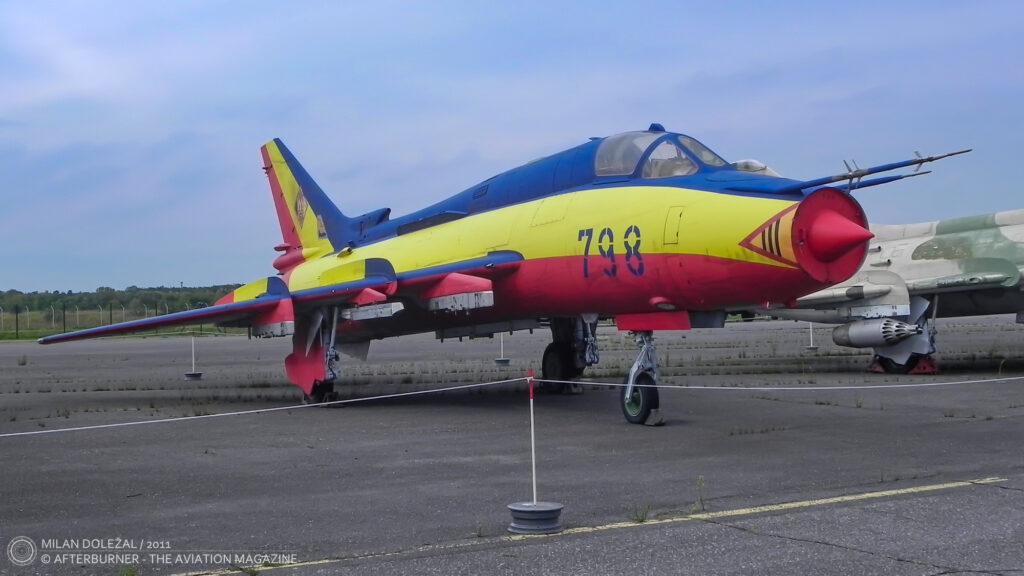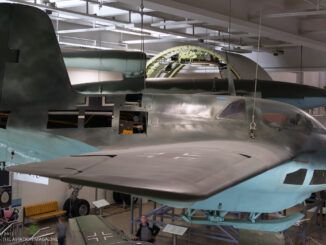 Sukhoi Su-22M4, NATO reporting name ´Fitter K´ (c/n 31406, formerly ´798´ of Luftstreitkräfte der Nationalen Volksarmee / the Air Forces of the National People’s Army and then 25+44 of the Luftwaffe), exhibited at Museum auf dem Flugplatz Berlin-Gatow (commonly known as Luftwaffenmuseum), Berlin, August 2011.
Sukhoi Su-22M4, NATO reporting name ´Fitter K´ (c/n 31406, formerly ´798´ of Luftstreitkräfte der Nationalen Volksarmee / the Air Forces of the National People’s Army and then 25+44 of the Luftwaffe), exhibited at Museum auf dem Flugplatz Berlin-Gatow (commonly known as Luftwaffenmuseum), Berlin, August 2011.
History of the Su-22 swept-wing fighter-bomber aircraft in the East Germany air force (Luftstreitkräfte der Nationalen Volksarmee – LSK) began in the early 1980s. At that time, the National People´s Army (NVA) launched construction of a new air base, located in Laage, a small town in the north part of the country, in the vicinity of Rostock. The new base was intended as home of two attack wings, equipped with the recently acquired modern combat aircraft, the Su-22.
In October of 1984, the first Su-22M4 (an export variant of Su-17M4) and Su-22UM3K (export variant of Su-17UM3 trainer) arrived to the East Germany but, due to construction works still ongoing at Laage, the aeroplanes were initially redirected to Rothenburg airfield. The first batch of the new fighter-bomber aircraft was assigned to Jagdbombenfliegergeschwader 77 ´Gebhard Leberecht von Blücher´ (the 77th Fighter-Bomber Wing – JGB 77).
In August of 1985, the second Su-22 squadron of the LSK was established at Laage. It was Marinefliegergeschwader 28 (the 28th Naval Aviation Wing – MFG-28) which, in the case of war, had to be assigned to Volksmarine (the People´s Navy) command. In later years, MFG-28 was named after Paul Wieczorek, a participant in the German Revolution of 1918-1919.
Both the Su-22 air wings at Laage were put under control of Gefechtsführungszentrum (Combat Command Centre) of the LSK in Strausberg. Each of them was equipped with twenty-four Su-22M4 and four Su-22UM3K, split into two squadrons.
In July of 1990, MFG-28 was eventually fully assigned to the People´s Navy. The personnel received naval ranks and the wing was officially announced as part of the naval aviation.
Nevertheless, it was just a swan song of the East German military aviation. On 27th September 1990, MFG-28 performed its final day as active and operational aviation unit. It was also the day the 28th Wing disclosed to public one of its Su-22, painted in blue-yellow-red stripes. They were the colours of the newly established German federal state of Mecklenburg-Vorpommern (Mecklenburg-Western Pomerania).
On 31st December 1990, Marinefliegergeschwader 28 was officially disbanded, however the first Luftwaffe personnel arrived to Laage air base yet in October, in order to take over the airfield and the aircraft. Following the reunification of Germany, the Ministry of Defence decided the Su-22s are no longer needed as frontline aircraft. Therefore, both MFG-28 and JGB-77 were turned into Nachkommando Laage – a second-line unit with task to preserve the aircraft in airworthy condition. All the Su-22s remaining in service received also the new Luftwaffe tactical numbers, with their codes beginning with 25+.
In the following years, some of the Su-22s were transferred to WTD 61 (Technical and Airworthiness Centre) at Manching for evaluation, where they remained in service until the end of 1990s. A few examples were taken over by the USAF and send to the United States for testing purposes. One of the Su-22 jets from WTD 61 was later evaluated by the Royal Air Force. It is also worth to mention that the aircraft used by Technical and Airworthiness Centre in Manching were maintained and serviced by Military Aviation Works No. 2 (WZL-2) in Bydgoszcz, Poland.
Approximately twenty examples of the Su-22 aircraft from Laage were donated for exhibition purposes and the remaining jets were scrapped.
The Su-22 featured within our Photo of the Week series was delivered to the LSK in October of 1986 and assigned to MFG-28. In October of 1990, the aircraft received new tactical code 25+44. Later on, it was transferred to Luftwaffenmuseum in Berlin-Gatow, where it is being exhibited until today.
An interesting fact is that similarly painted Su-22M4 can be seen at Auto und Technik Museum in Sinsheim, Germany. However, the aircraft at Sinsheim is in fact the Su-22 with c/n 26307 (formerly ´704´ of the LSK and 25+20 of the Luftwaffe) which was only repainted to look as the ´798´.



